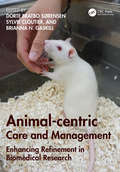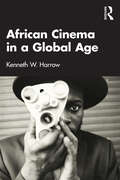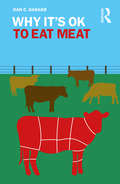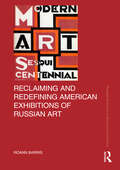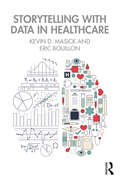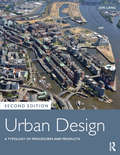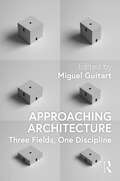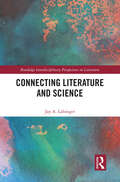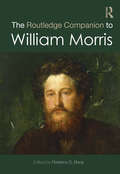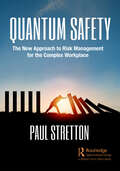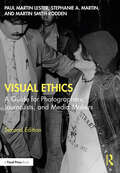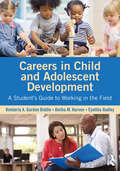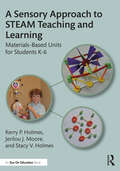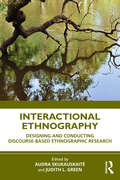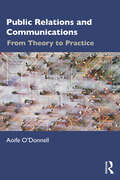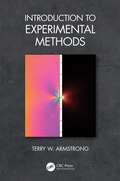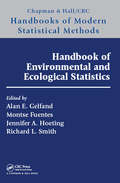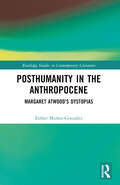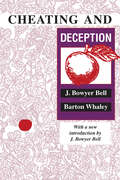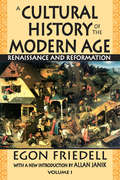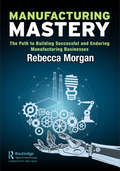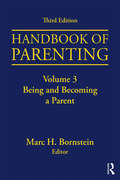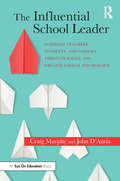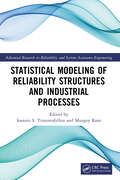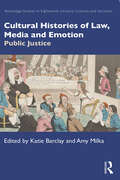- Table View
- List View
Animal-centric Care and Management: Enhancing Refinement in Biomedical Research
by Dorte Bratbo Sørensen, Sylvie Cloutier, and Brianna N. GaskillThe concept of the 3Rs (Refinement, Reduction and Replacement) has been used as a framework for improving the welfare of laboratory animals for the last half century. By establishing an animal-centric view on housing and management, Animal-centric Care and Management: Enhancing Refinement in Biomedical Research takes Russell and Burch’s definition of Refinement as "elimination of inhumanities" and goes further. Rather than fitting animals into experimental conditions, it encourages readers to adjust conditions to better meet the behavioral, emotional, physical, and physiological needs and preferences of the animals. The team of expert authors, from the fields of laboratory animal science, ethology, biology as well as animal training, provide ideas for creating housing conditions and handling procedures that induce, to the best of current abilities and knowledge, a long-term positive state of mind in the animals under our care. This book is written for animal caretakers, animal health technicians, researchers, animal facility managers, laboratory animal veterinarians, and anyone who engages in work with living experimental animals or is interested in the continuous improvement of laboratory animal welfare. This interdisciplinary guide will act as a catalyst, resulting in multiple viewpoints and fields collaborating to optimize laboratory animal welfare.
African Cinema in a Global Age
by Kenneth W. HarrowThis book traces the developments in African films that were made from the 1990s to the present within the evolving frame of what came to be called ‘World Cinema’ and, eventually, ‘Global Cinema.’Kenneth W. Harrow explores how, from the time video and then digital technologies were introduced in the 1990s, and then again, when streaming platforms assumed major roles in producing and distributing film between the 2010s and 2020s, African cinema underwent enormous changes. He highlights how the introduction of the continent’s first successful commercial cinema, Nollywood, shifted the focus from engagé films, with social or political messages, to entertainment movies, but also auteur cinema. Harrow explores how this transformation liberated African filmmakers and resulted in an incredible, enduring flow of creative, inventive, and thoughtful filmmaking. This book presents a number of those critical films that mark that trajectory, projecting a new sense of African film spaces and temporalities, while also highlighting how African films continue to find independent pathways. This book will be of interest to students and scholars of African cinema and world cinema, as well as researchers specifically examining African cinemas and their relationship to globalization.
Why It's OK to Eat Meat (Why It's OK)
by Dan C. ShaharVegetarians have argued at great length that meat-eating is wrong. Even so, the vast majority of people continue to eat meat, and even most vegetarians eventually give up on their diets. Does this prove these people must be morally corrupt? In Why It’s OK to Eat Meat, Dan C. Shahar argues the answer is no: it’s entirely possible to be an ethical person while continuing to eat meat—and not just the "fancy" offerings from the farmers' market but also the regular meat we find at most supermarkets and restaurants. Shahar’s examination forcefully echoes vegetarians’ concerns about the meat industry’s impacts on animals, workers, the environment, and public health. However, he shows that the most influential ethical arguments for avoiding meat on the basis of these considerations are ultimately unpersuasive. Instead of insisting we all become vegetarians, Shahar argues each of us has broad latitude to choose which of the world’s problems to tackle, in what ways, and to what extents, and hence people can decline to take up this particular form of activism without doing anything wrong.Key Features First book-length defense of meat-eating written for a popular audience Punchy, accessible introduction to the multifaceted debate over the ethics of eating meat Includes pioneering new examinations of humane labeling practices Shows why appeals to universalized patterns of behavior can’t vindicate vegetarians’ claims that there’s a duty to avoid meat Develops a novel theory of ethical activism with potential applications to a wide range of other issues
Reclaiming and Redefining American Exhibitions of Russian Art (Routledge Research in Art Museums and Exhibitions)
by Roann BarrisThis book examines the history of American exhibitions of Russian art in the twentieth century in the context of the Cold War. Because this history reflects changes in museological theory and the role of governments in facilitating or preventing intercultural cooperation, it uncovers a story that is far more complex than a chronological listing of exhibition names and art works. Roann Barris considers questions of stylistic appropriations and influences and the role of museum exhibitions in promoting international and artistic exchanges. Barris reveals that Soviet and American exchanges in the world of art were extensive and persistent despite political disagreements before, during, and after the Cold War. It also reveals that these early exhibitions communicated contradictory and historically invalid pictures of the Russian or Soviet avant-garde. The book will be of interest to scholars working in art history, museum studies, and Russian studies.
Storytelling with Data in Healthcare
by Kevin Masick Eric BouillonWith the constant evolution of change in healthcare from both a technology and governmental perspective, it is imperative to take a step back and view the big picture. Relying on hunches or beliefs is no longer sustainable, so avoid jumping to conclusions and making decisions without thoroughly understanding the statistics being analyzed. The triple aim of statistics is a conceptual model laying the foundation for improving healthcare outcomes through statistics. This foundation is: know your numbers; develop behavioral interventions; and set goals to drive change.With the availability of electronic data sources, the quantity and quality of data have grown exponentially to the point of information overload. Translating all this data into words that tell a meaningful story is overwhelming. This book takes the reader on a journey that navigates through this data to tell a story that everyone can understand and use to drive improvement. Readers will learn to tell a narrative story based on data, to develop creative, innovative and effective solutions to improve processes and outcomes utilizing the authors’ tools. Topics include mortality and readmission, patient experience, patient safety survey, governmental initiatives, CMS Star Rating and Hospital Compare.Storytelling with Data in Healthcare combines methodology and statistics in the same course material, making it coherent and easier to put into practice. It uses storytelling as a tool for knowledge acquisition and retention and will be valuable for courses in nursing schools, medical schools, pharmacy schools or any healthcare profession that has a research design or statistics course offered to students. The book will be of interest to researchers, academics, healthcare professionals, and students in the fields of healthcare management and operations as well as statistics and data visualization.
Urban Design: A Typology of Procedures and Products
by Jon LangUrban Design: A Typology of Procedures and Products, 2nd Edition provides a comprehensive and accessible introduction to urban design, defining the field and addressing the controversies and goals of urban design. Including over 50 updated international case studies, this new edition presents a three-dimensional model with which to categorize the processes and products involved: product type, paradigm type, and procedural type. The case studies not only illuminate the typology but provide information that designers can use as precedents in their own work. Uniquely, these case study projects are framed by the design paradigm employed, categorized by procedural type instead of instrumental or land use function. The categories used here are Total Urban Design, All-of-a-piece Urban Design, Plug-in Urban Design, and Piece-by-piece Urban Design.Written for both professionals and those encountering urban design in their day-to-day life, Urban Design is an essential introduction to the field and practice, considering the future direction of the field and what can be learned from the past.
Approaching Architecture: Three Fields, One Discipline
by Miguel GuitartThe study of the architectural discipline suffers from an increasing disconnect between its teaching and its professional practice. In this edited collection, 18 architectural voices address this disconnect by reflecting on the ways in which they exercise the architectural discipline in three ways: research, teaching, and practice. This book argues that the totality of activities encompassed by the architectural profession can be best fulfilled when reconsidering the critical interactions between these three fields in the everyday exercise of the profession. Split into three parts, "Architecture as Research," Architecture as Pedagogy," and "Architecture as Practice," each section focuses on one of these three dimensions while establishing continuity with the other two. In doing so, the book not only favors a more fulfilling interaction between academia and the profession but also reinforces the implementation of design theory and research in everyday teaching and practice. The contributions come from 18 teams of architects operating from geographically diverse locations, including Pezo von Ellrichshausen in Chile, Kengo Kuma & Associates in Japan, Barclay & Crousse in Peru, Shift in Iran, Heinrich Wolff in South Africa, and People’s Architecture Office in China, opening the design conversation to larger contexts and framing continuity and inclusion in time. Written for students, instructors, and practitioners alike, the inspiring reflections in this volume encourage readers to grow as architects and play an instrumental role in transforming the built environment.
Connecting Literature and Science (Routledge Interdisciplinary Perspectives on Literature)
by Jay A. LabingerThis book presents a case for engagement between the sciences and the humanities. The author, a professional chemist, seeks to demonstrate that the connections between those fields of intellectual activity are far more significant than anything that separates them. The book combines a historical survey of the relationships between science and literature with a number of case studies that examine specific scientific episodes—several drawn from the author’s own research—juxtaposed with a variety of literary works spanning a wide range of period and genre—Dante to detective fiction, War and Peace to White Teeth—to elicit their common themes. The work argues for an empirical, non-theory-based approach, one that is closely analogous to connectionist models of brain development and function, and that can appeal to general readers, as well as to literary scholars and practicing scientists, who are open to the idea that literature and science should not be compartmentalized.
The Routledge Companion to William Morris (Routledge Art History and Visual Studies Companions)
by Florence S. BoosWilliam Morris (1834–96) was an English poet, decorative artist, translator, romance writer, book designer, preservationist, socialist theorist, and political activist, whose admirers have been drawn to the sheer intensity of his artistic endeavors and efforts to live up to radical ideals of social justice. This Companion draws together historical and critical responses to the impressive range of Morris’s multi-faceted life and activities: his homes, travels, family, business practices, decorative artwork, poetry, fantasy romances, translations, political activism, eco-socialism, and book collecting and design. Each chapter provides valuable historical and literary background information, reviews relevant opinions on its subject from the late-nineteenth century to the present, and offers new approaches to important aspects of its topic. Morris’s eclectic methodology and the perennial relevance of his insights and practice make this an essential handbook for those interested in art history, poetry, translation, literature, book design, environmentalism, political activism, and Victorian and utopian studies.
Quantum Safety: The New Approach to Risk Management for the Complex Workplace
by Paul StrettonThis book is the most comprehensive review of health and safety in half a century. Most organisational approaches to health and safety are based on the methodology developed during the 1970s, and despite the workplace changing beyond recognition since that time, these approaches have remained untouched. Quantum Safety will develop a new understanding fit for the modern workplace. Quantum Safety is an approach that is part of the "new view" debate. There have been a number of other new approaches to health and safety in recent years, and while they all have merit and improve understanding to help create the optimal, safe working environment, they have failed to significantly create the change desired. These approaches are often flawed at the philosophical or conceptual level or propose a solution without a pathway to implement the principles in safety-critical environments. Quantum Safety: The New Approach to Risk Management for the Complex Workplace is founded on a wholesale critical analysis of the conceptual foundations of health and safety before translating the revised principles into a tangible methodology. Central to the development of Quantum Safety is the application of Complexity Science. The traditional approach to health and safety is considered to be Newtonian – it uses linear models and deterministic analysis. Quantum Safety, due to the full consideration of Complexity Science, introduces multidimensional models and develops analysis based on probabilities. Crucially, this does not render Newtonian methodologies as worthless – in the same manner that Newtonian physics was able to take mankind to the moon, but required the quantum understanding within computers to make it possible – Quantum Safety provides the mechanisms to complete organisations’ safety-based journeys. The new mechanisms are fully developed for the reader at both macro and micro levels. How an organisation measures safety and what it values are reset and re-examined. How we investigate adverse events and the consequential actions taken with employees to develop a true Just Culture within a high-performing culture are also completely revised. Essentially, Quantum Safety creates a pathway for understanding health and safety in the complex modern world. To achieve that, new models are introduced to replace the dated, simple tools and a new language is developed to communicate this powerful approach. It will help propel an organisation from considering safety within a concept of industrialised failure avoidance to valuing safety as an integrated aspect of high performance.
Visual Ethics: A Guide for Photographers, Journalists, and Media Makers
by Paul Martin Lester Stephanie A. Martin Martin Smith-RoddenAn indispensable guide to visual ethics, this book addresses the need for critical thinking and ethical behavior among students and professionals responsible for a variety of mass media visual messages.Written for an ever-growing discipline, authors Paul Martin Lester, Stephanie A. Martin, and Martin Rodden-Smith give serious ethical consideration to the complex field of visual communication. The book covers the definitions and uses of six philosophies, analytical methods, cultural awareness, visual reporting, documentary, citizen journalists, advertising, public relations, typography, graphic design, data visualizations, cartoons, motion pictures, television, computers and the web, augmented and virtual reality, social media, the editing process, and the need for empathy. At the end of each chapter are case studies for further analysis and interviews with thoughtful practitioners in each field of study, including Steven Heller and Nigel Holmes. This second edition has also been fully revised and updated throughout to reflect on the impact of new and emerging technologies.This book is an important resource for students of photojournalism, photography, filmmaking, media and communication, and visual communication, as well as professionals working in these fields.
Careers in Child and Adolescent Development: A Student's Guide to Working in the Field
by Kimberly A. Gordon Biddle Aletha M. Harven Cynthia HudleyChild and Adolescent Development is a rich and continuously evolving field that offers a wealth of career opportunities. Careers in Child and Adolescent Development is the first textbook to guide students along each step of the career path—from the levels of academic degrees and programs available, to preparations for the professional world. It presents a brief description of the field, explores a broad array of career paths available to students, and offers some practical ideas for constructing a career plan. Students are provided with practical, up-to-date information about career opportunities, combined with real-life vignettes to illustrate the challenges and rewards these careers hold. The book presents traditional career paths in fields such as child and adolescent development, elementary education, educational leadership, and school counseling, as well as non-traditional or emerging career paths in child life and behavior analysis, research, academia, non-profit work, children’s ministry, and family law. It will serve as a go-to reference for students, and can be used in a fieldwork class, a service learning class, a professional development class, or a capstone class.
A Sensory Approach to STEAM Teaching and Learning: Materials-Based Units for Students K-6
by Kerry P. Holmes Jerilou J. Moore Stacy V. HolmesDid you know you have the power and the materials at your fingertips to facilitate the actual brain growth of students?This book is a practical resource to engage K-6 students with STEAM content through their five senses: seeing, listening, touch/movement, smell and taste. It combines historical research, practical suggestions, and current practices on the stages of cognitive development and the brain’s physical response to emotion and novelty; to help you learn ways to transform ordinary lesson plans into novel and exciting opportunities for students to learn through instruction, exploration, inquiry, and discovery.In addition to providing examples of sensory-rich unit plans, the authors take you through the step-by-step process on how to plan a thematic unit and break it down into daily seamless lesson plans that integrate science, technology, engineering, arts, and mathematics.With 25 themed STEAM unit plans and activities based on national standards, up-to-date research on brain science, and real classroom experience, this book shows multiple ways to develop and deliver active multisensory activities and wow your students with sights and sounds as soon as they come through the door of your classroom.
Interactional Ethnography: Designing and Conducting Discourse-Based Ethnographic Research
by Audra SkukauskaitėFocusing specifically on Interactional Ethnography (IE) as a distinct, discourse-based form of ethnography, this book introduces readers to the logic and practice behind IE and exemplifies the logic of ethnographic inquiry through a range of example-based chapters.Edited by two of the foremost scholars in the field of IE, this book brings together a body of work that has until now been largely dispersed. Illustrating how IE intersects with ethnographic methods – including observation, interviews, and fieldwork – the book highlights considerations relating to data analysis, researcher positionality, and the ethics of engaging participants in research. Offering examples of IE in international contexts and across a range of social science and educational settings, the book provides foundational principles and key examples of IE to guide readers’ work.This book offers researchers, scholars, and teacher educators a definitive, novel contribution to current methodological literature on IE broadly, and will be of particular use to ethnographers starting out in their career. Due to the interdisciplinary nature of the volume in illustrating the use of IE in a range of educational sub-disciplines, the book’s relevance extends to the fields of medical education, teacher education, arts and literacy research, as well as providing situated examples of IE in settings with relevance to the social sciences, anthropology, and cultural studies.
Public Relations and Communications: From Theory to Practice
by Aoife O'DonnellThis book provides an introduction to public relations (PR) that employs pedagogical experiential learning models to assist students in developing the skills and competencies required by the PR industry.The book takes the reader on a journey from the theory and origins of PR, through to the structure of the PR profession and the more practical elements of how PR is practiced today. It devotes attention to the common competencies necessary for success as a communications professional, such as communication skills, critical thinking skills and business acumen, while giving due focus to the rapidly evolving new technologies and media that impact how organisations communicate. Featuring example cases from around the world, each chapter includes discussion topics and scenario-based questionnaires to encourage learning and assist students in developing key competencies.This book is ideal for undergraduate PR modules, particularly those with experiential and/or blended learning pedagogical approaches. It will also be useful to those in business seeking to gain a deeper understanding of communications.Situational Judgement Tests and sample press releases, presented as online resources, also accompany the book. Please visit www.routledge.com/9781032170435.
Introduction to Experimental Methods
by Terry W. ArmstrongIntroduction to Experimental Methods succinctly explains fundamental engineering concepts in mechanics, dynamics, heat transfer, and fluid dynamics. From conceptualizing an engineering experiment to conducting a comprehensive lab, this book enables students to work through the entire experimental design process.Offering a complete overview of instruction for engineering lab methodology, the book includes practical lab manuals for student use, directly complementing the instruction. Numerous worked examples and problems are presented along with several hands-on experiments in individual lab manuals. This book discusses how to write lab reports, how to configure a variety of instruments and equipment, and how to work through failures in experimentation.Introduction to Experimental Methods is intended for senior undergraduate engineering students taking courses in Experimental Methods. Instructors will be able to utilize a Solutions Manual for their course.Features: Provides an overview of experimental methods in mechanics, dynamics, heat transfer, and fluid dynamics Covers design of experiments, instruments, and statistics Discusses SolidWorks and PASCO Capstone software Includes numerous end-of-chapter problems and worked problems Features a Solutions Manual for instructor use
Handbook of Environmental and Ecological Statistics (ISSN)
by Alan Gelfand; Montse Fuentes; Jennifer A. Hoeting; Richard L. SmithThis handbook focuses on the enormous literature applying statistical methodology and modelling to environmental and ecological processes. The 21st century statistics community has become increasingly interdisciplinary, bringing a large collection of modern tools to all areas of application in environmental processes. In addition, the environmental community has substantially increased its scope of data collection including observational data, satellite-derived data, and computer model output. The resultant impact in this latter community has been substantial; no longer are simple regression and analysis of variance methods adequate. The contribution of this handbook is to assemble a state-of-the-art view of this interface. Features: An internationally regarded editorial team. A distinguished collection of contributors. A thoroughly contemporary treatment of a substantial interdisciplinary interface. Written to engage both statisticians as well as quantitative environmental researchers. 34 chapters covering methodology, ecological processes, environmental exposure, and statistical methods in climate science.
Posthumanity in the Anthropocene: Margaret Atwood's Dystopias (Routledge Studies in Contemporary Literature)
by Esther Muñoz-GonzálezIn this book, Margaret Atwood’s dystopian novels—The Handmaid’s Tale, the MaddAddam trilogy, The Heart Goes Last, and The Testaments—are analyzed from the perspective provided by the combined views of the construction of the posthuman subject in its interactions with science and technology, and the Anthropocene as a cultural field of enquiry. Posthumanist critical concerns try to dismantle anthropocentric notions of the human and defend the need for a closer relationship between humanity and the environment. Supported by the exemplification of the generic characteristics of the cli-fi genre, this book discusses the effects of climate change, at the individual level, and as a collective threat that can lead to a "world without us." Moreover, Margaret Atwood is herself the constant object of extensive academic interest and Posthuman theory is widely taught, researched, and explored in almost every intellectual field. This book is aimed at worldwide readers, not only those interested in Margaret Atwood’s oeuvre, but also those interested in the debate between critical posthumanism and transhumanism, together with the ethical implications of living in the Anthropocene era regarding our daily lives and practices. It will be especially attractive for academics: university teachers, postgraduates, researchers, and college students in general.
Cheating and Deception
by J. Bowyer Bell Barton WhaleyCheating and deception are terms often used but rarely defined. They summon up unpleasant connotations; even those deeply involved with cheating and deception rationalize why they have been driven to it. Particularly for Americans and much of Western civilization, official cheating, government duplicity, cheating as policy, and conscious, contrived deception, are all unacceptable except as a last resort in response to threat of extinction. As a distasteful tool, deception is rarely used to achieve national interests, unless in relation to the deployment of military force. As an area of study, it has by and large been ignored.Intrigued by attitudes toward cheating and deception, the authors decided to analyze its roots, structure, and process. They asked fundamental questions: are there categories of deception, general steps in the process of deception, and ways to evaluate its results across time and in different modes? The book that results is a typology of kinds of deception, beginning with military deception, but extending into other categories and stages.In his introduction to this new edition, Bell outlines how the book came to be written, describes the mixed emotions toward the subject displayed by govenmental and nongovernmental funding sources, and speculates about its critical and commercial reception. He discusses widespread new interest in the subject, the research that has been undertaken since this book was first published, and its limitations.This book provides a general overview of this complex subject, creating a framework for analysis of specific instances of cheating or deception. It will be of particular interest to political scientists, those interested in military affairs and strategy, and psychologists. The general reader will find the book written with a light touch, drawing examples of cheating and deception in the pursuit of love and money. The specialist reader will be intrigued by its broad-ranging examples drawn from policy and politics,
A Cultural History of the Modern Age: Volume 1, Renaissance and Reformation
by Egon FriedellHistorian, philosopher, critic, playwright, journalist, and actor, Egon Friedell was a key figure in the extraordinary flowering of Viennese culture between the two world wars. His masterpiece, A Cultural History of the Modern Age, demonstrates the intellectual universality that Friedell saw as guarantor of the continuity and regeneration of European civilization. Following a brilliant opening essay on cultural history and why it should be studied, the first volume begins with an analysis of the transformation of the Medieval mind as it evolved from the Black Death to the Thirty Years War. The emphasis is on the spiritual and cultural vortex of civilization, but Friedell never forgets the European roots in pestilence, death, and superstition that animate a contrary drive toward reason, refinement, intellectual curiosity, and scientific knowledge. While these values reached their apogee during the Renaissance, Friedell shows that each cultural victory is precarious, and Europe was always in danger of slipping back into barbarism. Friedell's historical vision embraces the whole of Western culture and its development. It is a consistent probing for the divine in the world's course and is, therefore, theology; it is research into the basic forces of the human soul and is, therefore, psychology; it is the most illuminating presentation of the forms of state and society and, therefore, is politics; the most varied collection of all art-creations and is, therefore, aesthetics. Thomas Mann regarded Friedell as one of the great stylists in the German language. Like the works of the great novelist, A Cultural History of the Modern Age offers a dramatic history of the last six centuries, showing the driving forces of each age. The new introduction provides a fascinating biographical sketch of Friedell and his cultural milieu and analyzes his place in intellectual history.
Manufacturing Mastery: The Path to Building Successful and Enduring Manufacturing Businesses
by Rebecca MorganWhile there are those who say manufacturing is dying, it is not and will not. Without a universal vow of poverty, growing economies will only increase demand. Manufacturing in the 21st century is not a question of if -- Rather, it is a function of why, what, who, where, and how. The nature and pace of change in those factors are overwhelming many. Fear, futile resistance, and uncertainty are common. While manufacturing will not die, individual manufacturing companies will if they do not learn to thrive in this new world. This book is a dynamic guide for manufacturing leaders who want to reduce the ambiguity and overwhelming changes and develop a realistic, progressive, and responsive thinking process that enables success. It provides a business operating system framework that is the foundation for connecting the many pieces of a manufacturing business into an effective, profitable operation. The author walks through the elements, relationships, capabilities, and mutability 21st-century manufacturing requires. Executives of manufacturing companies will be better able to think about and execute viable strategies leveraging the changing economy. Essentially, manufacturing is becoming increasingly complex, as are business and socioeconomic and political realities. Rapidly evolving technology adds to the confusing environment that precludes “more of the same, better, faster and cheaper” as a workable business strategy. The tsunami of information hitting owners and leaders is overwhelming many, and it is easy to become frozen in place. Economic growth and improving standards of living require that all of this change be broken into bite-size understandable pieces that thaw the minds of executives, allowing them to assess what is best right now, and move forward. This book does not overwhelm with details and models; rather it provides thinking and examples in small chunks that enable manufacturers to develop and master skills for high-level strategic leadership in ambiguity.
Handbook of Parenting: Volume 3: Being and Becoming a Parent, Third Edition
by Marc H. BornsteinThis highly anticipated third edition of the Handbook of Parenting brings together an array of field-leading experts who have worked in different ways toward understanding the many diverse aspects of parenting. Contributors to the Handbook look to the most recent research and thinking to shed light on topics every parent, professional, and policymaker wonders about. Parenting is a perennially "hot" topic. After all, everyone who has ever lived has been parented, and the vast majority of people become parents themselves. No wonder bookstores house shelves of "how-to" parenting books, and magazine racks in pharmacies and airports overflow with periodicals that feature parenting advice. However, almost none of these is evidence-based. The Handbook of Parenting is. Period. Each chapter has been written to be read and absorbed in a single sitting, and includes historical considerations of the topic, a discussion of central issues and theory, a review of classical and modern research, and forecasts of future directions of theory and research. Together, the five volumes in the Handbook cover Children and Parenting, the Biology and Ecology of Parenting, Being and Becoming a Parent, Social Conditions and Applied Parenting, and the Practice of Parenting.Volume 3, Being and Becoming a Parent, considers a large cast of characters responsible for parenting, each with her or his own customs and agenda, and examines what the psychological characteristics and social interests of those individuals reveal about what parenting is. Chapters in Part I, on The Parent, show just how rich and multifaceted is the constellation of children’s caregivers. Considered first are family systems and then successively mothers and fathers, coparenting and gatekeeping between parents, adolescent parenting, grandparenting, and single parenthood, divorced and remarried parenting, lesbian and gay parents and, finally, sibling caregivers and nonparental caregiving. Parenting also draws on transient and enduring physical, personality, and intellectual characteristics of the individual. The chapters in Part II, on Becoming and Being a Parent, consider the intergenerational transmission of parenting, parenting and contemporary reproductive technologies, the transition to parenthood, and stages of parental development, and then chapters turn to parents' well-being, emotions, self-efficacy, cognitions, and attributions as well as socialization, personality in parenting, and psychoanalytic theory. These features of parents serve many functions: they generate and shape parental practices, mediate the effectiveness of parenting, and help to organize parenting.
The Influential School Leader: Inspiring Teachers, Students, and Families Through Social and Organizational Psychology
by Craig Murphy John D'AuriaThe Influential School Leader is a unique, accessible guide for any leader seeking to improve their vision and positively influence school communities in the face of adversity. A successful school today requires a nimble learning environment that is supportive, welcoming, and inspiring for teachers, students, and families. Based on numerous contributions from social and organizational psychology, this book provides a dynamic framework that prepares education stakeholders to examine problems from multiple perspectives and dimensions to create durable solutions. An ideal resource for principals, superintendents, department heads, school psychologists, and other educators in positions of leadership, this expansive toolkit is packed with pragmatic strategies and relatable vignettes.
Statistical Modeling of Reliability Structures and Industrial Processes (ISSN)
by Ioannis S. Triantafyllou Mangey RamThis reference text introduces advanced topics in the field of reliability engineering, introduces statistical modeling techniques, and probabilistic methods for diverse applications.It comprehensively covers important topics including consecutive-type reliability systems, coherent structures, multi-scale statistical modeling, the performance of reliability structures, big data analytics, prognostics, and health management. It covers real-life applications including optimization of telecommunication networks, complex infrared detecting systems, oil pipeline systems, and vacuum systems in accelerators or spacecraft relay stations. The text will serve as an ideal reference book for graduate students and academic researchers in the fields of industrial engineering, manufacturing science, mathematics, and statistics.
Cultural Histories of Law, Media and Emotion: Public Justice (Routledge Studies in Eighteenth-Century Cultures and Societies)
by Katie BarclayCultural Histories of Law, Media and Emotion: Public Justice explores how the legal history of long-eighteenth-century Britain has been transformed by the cultural turn, and especially the associated history of emotion.Seeking to reflect on the state of the field, 13 essays by leading and emerging scholars bring cutting-edge research to bear on the intersections between law, print culture and emotion in Britain across the eighteenth and nineteenth centuries. Divided into three sections, this collection explores the ‘public’ as a site of legal sensibility; it demonstrates how the rhetoric of emotion constructed the law in legal practice and in society and culture; and it highlights how approaches from cultural and emotions history have recentred the individual, the biography and the group to explain long-running legal-historical problems. Across this volume, authors evidence how engagements between cultural and legal history have revitalised our understanding of law’s role in eighteenth-century culture and society, not least deepening our understanding of justice as produced with and through the public.This volume is the ideal resource for upper-level undergraduates, postgraduates and scholars interested in the history of emotions as well as the legal history of Britain from the late seventeenth to the nineteenth century.
